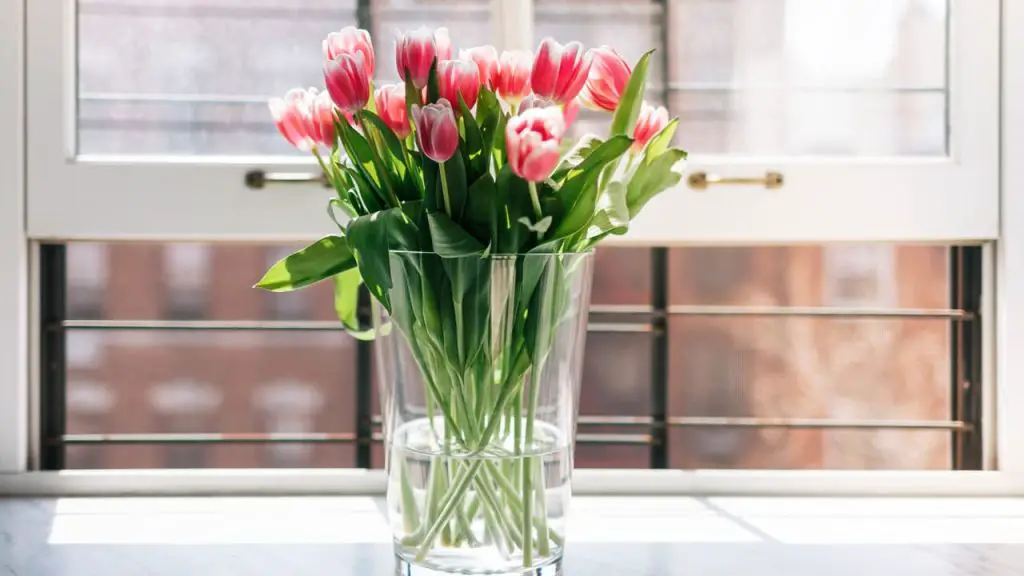Tulips are one of the world’s most popular and beloved spring-blooming flowers, known for their vibrant colors and delicate petals. Today, tulips can be found in gardens, parks, and flower shops worldwide, bringing joy and beauty to people’s lives.
In this blog post, we’ll be discussing how to take care of tulips indoors, so you can enjoy these gorgeous flowers year-round. Whether you are a seasoned gardener or a beginner you‘ll find helpful tips and advice on how to grow and care for tulips indoors.
So let’s get started with the best tulip options for your indoor cultivation
1. Choosing the Right Tulip Varieties for Indoor Gardening

1.1 Choose the Right Color
Tulips come in a wide variety of colors, ranging from bright reds and yellows to pastel pinks and purples. When choosing tulips for your indoor garden, consider the color scheme of your home and choose tulips that complement it.
If you want a bold, vibrant look, go for tulips in bright, eye-catching colors like red, yellow, or orange. If you prefer a more subtle look, pastel-colored tulips like soft pink or light purple may be a perfect choice.
1.2 Consider the Size
Tulips come in a range of sizes, from small-species tulips to large-flowered hybrids. When choosing tulips for indoor gardening, consider the size of your container and choose tulips that will fit comfortably without overcrowding.
Smaller tulip varieties like species tulips are perfect for smaller containers, while larger-flowered hybrids like Darwin tulips or Triumph tulips are ideal for larger containers.
1.3 Choose the Right Shape
Tulips come in a variety of shapes, from classic cup-shaped tulips to unique fringed or parrot tulips. Consider the overall aesthetic you want to create in your indoor garden and choose tulips that fit that vision.
Classic cup-shaped tulips are timeless and elegant, while fringed and parrot tulips add a touch of whimsy and playfulness to your indoor garden.
1.4 Blooming Time
Tulips bloom at different times depending on the variety, so consider when you want your indoor tulips to bloom. Early-blooming tulips like Kaufmanniana tulips and Fosteriana tulips will bloom in late winter to early spring, while mid-season tulips like Darwin tulips and Triumph tulips will bloom in mid-spring.
Late-blooming tulips like Single Late tulips and Double Late tulips will bloom in late spring to early summer.
2. How To Take Care Of Tulips Indoors?
Taking care of tulips can be a daunting task, especially if you’re new to gardening. But fear not, because in this paragraph we’ll be discussing the best tulip care for indoor gardening.
So sit back, relax, and get ready to learn how to perfectly take care of indoor gardening.
2.1 Choose the right bulbs
The first step in caring for tulips indoors is to choose the right bulbs. When you’re choosing tulip bulbs, you want to make sure they’re in good condition. Healthy bulbs should feel firm to the touch, with no soft or mushy spots.
If a bulb feels light or hollow, it may be dried out or damaged. If you notice any signs of mold or decay on a bulb, such as fuzzy patches or discolored spots, it’s best to avoid them.
These bulbs are unlikely to thrive and may even spread disease to other plants. Some tulip varieties are better suited for growing outdoors in a garden, while others are more adaptable to indoor conditions.
For example, certain types of tulips may require more sunlight, cooler temperatures, or a longer period of cold dormancy than you can provide indoors. Look for bulbs that are specifically labeled as suitable for indoor growing, or do some research to determine which varieties are likely to do well in your home environment.
2.2 Select the right container
Once you have chosen your bulbs, the next step is to select the right container. You want to choose a container that is large enough to accommodate the bulbs and their roots, but not so large that it will be difficult to move or water.
Make sure that the container has good drainage, as tulips do not like to be waterlogged.
2.3 Plant the bulbs
Tulip bulbs should be planted at a depth of about three times their own height. This means that a larger bulb will need to be planted deeper than a smaller one.
Planting bulbs at the correct depth will help to protect them from fluctuations in temperature and moisture, and ensure that they have access to the nutrients and moisture they need to grow. When planting tulip bulbs, make sure that you orient them correctly.
The pointed end of the bulb should be facing up, while the flat end should be facing down. This will help to ensure that the bulb can sprout and send up new growth. When planting tulip bulbs, it’s a good idea to plant them close together, but not touching.
This will help to ensure that the plants grow upright and don’t flop over as they mature. It will also create a more attractive display of flowers when they bloom.
2.4 Provide adequate light
Tulips need plenty of light in order to grow and produce blooms, and natural sunlight is the best source of light for them. When growing tulips indoors, try to place the container in a location that receives at least six hours of direct sunlight each day.
A south-facing window is usually the best option, as it will provide the most sunlight throughout the day. If you don’t have access to a location that receives enough natural light, you can also supplement it with artificial light.
Grow lights or full-spectrum bulbs can provide the necessary light for tulips to grow and bloom. Be sure to keep the bulbs close to the plants, as most artificial lights are not as intense as natural sunlight.
While tulips need plenty of light, they also prefer cooler temperatures. Avoid placing the container in a location that gets too hot, such as near a radiator or heat source. This can cause the plants to become stressed and may even prevent them from blooming.
2.5 Water and fertilize regularly
When it comes to watering your tulips, it’s important to strike a balance between keeping the soil moist and avoiding overwatering. Tulips like soil that is evenly moist, but not waterlogged.
If you water too much, the soil can become too saturated and the roots can rot, which can lead to the death of the plant. On the other hand, if you don’t water enough, the tulips may not receive enough moisture to grow properly.
To water your tulips properly, you should aim to keep the soil evenly moist, but not soggy. This may require watering every few days or so, depending on the conditions in your home. You can test the soil by sticking your finger into it; if it feels dry to the touch, it’s time to water.
Fertilization is also important for the growth and blooming of tulips. A balanced, water-soluble fertilizer can provide your tulips with the necessary nutrients to grow strong and healthy.
When fertilizing, it’s important to follow the manufacturer’s instructions and not overdo it, as too much fertilizer can be harmful to the plant.
In general, it’s recommended to fertilize your tulips every two weeks during their growing season. This can help to ensure that they receive a steady supply of nutrients without overwhelming them.
2.6 Monitor for pests and disease
Monitoring your tulips for pests and diseases is an important part of caring for them indoors. There are several common pests and diseases that can affect tulips, including aphids, spider mites, thrips, fungal diseases, and viral diseases.
Some signs that your tulips may be affected by pests or disease include yellowing or browning leaves, wilting flowers, stunted growth, and distorted or discolored leaves. If you notice any of these symptoms, it’s important to take action immediately to prevent further damage.
One way to prevent pests and diseases is to keep your tulips in a clean and well-ventilated environment. Avoid overcrowding your plants, as this can create a humid and damp environment that is conducive to the growth of fungi and other pathogens.
You can also use organic pest control methods, such as neem oil or insecticidal soap, to help prevent or treat infestations.
If you suspect that your tulips may be infected with a disease, it’s important to remove any affected leaves or flowers immediately and dispose of them in the trash. Do not compost them, as this can spread the disease to other plants. You may also need to treat the soil with fungicides or other treatments to prevent the spread of the disease.
In general, by monitoring your tulips regularly for signs of pests and disease, you can help to catch and treat any issues early on, before they have a chance to cause serious damage. This can help to ensure that your tulips grow and bloom beautifully all season long.
2.7 Maintain proper temperature and humidity
Finally, make sure that you maintain the proper temperature and humidity levels for your tulips. In terms of temperature, tulips prefer cooler conditions. Ideally, they should be kept in an environment with temperatures between 60-65 degrees Fahrenheit (15-18 degrees Celsius).
If the temperature gets too warm, the tulips may start to wilt and deteriorate more quickly.
In terms of humidity, tulips prefer a higher level of moisture in the air. This is because tulips come from regions with higher humidity levels, such as the mountains of Central Asia.
When the air is too dry, the tulips may start to dry out and lose their vibrant colors more quickly.
To maintain the proper humidity level for your tulips, you can place a tray of water near them or use a humidifier. The water will evaporate into the air, increasing the moisture content and helping to keep your tulips healthy and vibrant.
Conclusion
In this article, we’ve covered important information on how to take care of tulips that you’ve grown indoors. We’ve also provided tips on how to select the right varieties for indoor gardening. With just a little bit of attention and care, your tulips can brighten up your home or garden and add a natural touch of beauty.
We sincerely hope that the information provided in this guide has been useful to you in caring for your tulips and ensuring that they last for years to come. Thank you for reading our blog post.
FAQ’s
What kind of soil do tulips need in indoor pots?
Tulips grow best in well-draining soil that is rich in nutrients. Use a high-quality potting mix with perlite or vermiculite to ensure proper drainage.
How do I prepare tulip bulbs for indoor winter care?
Tulip bulbs need a period of dormancy before they can bloom again. Store the bulbs in a cool, dry place for at least 6 to 8 weeks before planting them in indoor pots for winter blooming.
Do indoor tulips need sunlight in winter?
Yes, tulips need sunlight to grow and bloom. Place your pots in a bright location with at least 6 hours of direct sunlight each day. If natural light is not available, you can use artificial grow lights to provide the necessary light.
Additional Posts:



